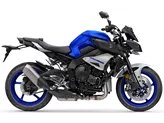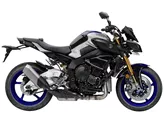Yamaha MT-10 2016 vs. Ducati Monster 1100 Evo 2013

Yamaha MT-10 2016

Ducati Monster 1100 Evo 2013
Pregled - Yamaha MT-10 2016 vs Ducati Monster 1100 Evo 2013
The Yamaha MT-10 2016 and the Ducati Monster 1100 Evo 2013 are both naked bikes that offer powerful performance and a unique riding experience. However, there are several key differences between the two models.
In terms of engine power, the Yamaha MT-10 2016 comes out on top with 160 HP, compared to the Ducati Monster 1100 Evo 2013's 100 HP. This means that the Yamaha has a significant advantage in terms of acceleration and top speed. Additionally, the Yamaha has a higher torque of 111 Nm, compared to the Ducati's 103 Nm. This results in better low-end power and responsiveness.
The Yamaha MT-10 2016 has a four-cylinder engine, while the Ducati Monster 1100 Evo 2013 has a two-cylinder engine. This difference in cylinder configuration affects the overall performance and sound of the bikes. The Yamaha's four-cylinder engine provides a strong and distinctive sound, adding to its character and appeal.
In terms of cooling, the Yamaha MT-10 2016 has a liquid-cooled engine, while the Ducati Monster 1100 Evo 2013 relies on air cooling. Liquid cooling is generally more efficient and allows for better temperature control, which can result in improved performance and reliability.
Both bikes have double disk brakes at the front, ensuring strong and reliable stopping power. This is important for a high-performance naked bike, as it allows for confident and controlled braking.

Yamaha MT-10 2016
In terms of dimensions, the Yamaha MT-10 2016 has a slightly narrower front tire width of 120 mm, compared to the Ducati Monster 1100 Evo 2013's 120 mm. However, the Ducati has a wider rear tire width of 180 mm, compared to the Yamaha's 190 mm. This difference in tire widths can affect the handling and stability of the bikes.
The Yamaha MT-10 2016 has a wheelbase of 1400 mm, while the Ducati Monster 1100 Evo 2013 has a slightly longer wheelbase of 1450 mm. A longer wheelbase can provide better stability at high speeds, while a shorter wheelbase can result in improved maneuverability and agility.
In terms of seat height, the Yamaha MT-10 2016 has a slightly higher seat height of 825 mm, compared to the Ducati Monster 1100 Evo 2013's 810 mm. This can affect the comfort and ergonomics of the bikes, depending on the rider's height and preference.
The Yamaha MT-10 2016 has a higher kerb weight of 210 kg, compared to the Ducati Monster 1100 Evo 2013's 188 kg. This can affect the handling and maneuverability of the bikes, especially at lower speeds or in tight corners.

Ducati Monster 1100 Evo 2013
Both bikes have a fuel tank capacity that is suitable for long rides, with the Yamaha MT-10 2016 offering a slightly larger capacity of 17 liters, compared to the Ducati Monster 1100 Evo 2013's 13.5 liters.
In terms of strengths, the Yamaha MT-10 2016 stands out for its CP4 engine, which provides a strong and distinctive character. It is also praised for its agility and high-speed stability, as well as its strong brakes. Additionally, the Yamaha has an unmistakable sound that adds to its appeal.
On the other hand, the Ducati Monster 1100 Evo 2013 is known for its enormous torque, which provides a thrilling and exhilarating riding experience. It is also praised for its manageability, making it easier to handle and control.
However, both bikes have their weaknesses. The Yamaha MT-10 2016 is criticized for its poor comfort, limited wind protection, and hard fit. These factors can affect the overall riding experience, especially on longer rides. On the other hand, the Ducati Monster 1100 Evo 2013 is criticized for its noticeable load changes and poorly readable instruments, which can affect the overall usability and convenience of the bike.
In conclusion, the Yamaha MT-10 2016 and the Ducati Monster 1100 Evo 2013 are both powerful and exciting naked bikes. While the Yamaha offers superior engine power and performance, the Ducati stands out for its torque and manageability. Ultimately, the choice between the two models will depend on the rider's preferences and priorities, whether it be raw power or a thrilling riding experience.
Tehnične specifikacije Yamaha MT-10 2016 v primerjavi z Ducati Monster 1100 Evo 2013
Primerjava prednosti in slabosti
Primerjava prednosti in slabosti
Yamaha MT-10 2016

The short and stocky MT-10 is the furthest away from the R1 superbike of the renowned power naked bikes, both in terms of looks and chassis, but the heart of the MT-10 is directly descended from the racetrack weapon and fascinates with a uniquely raw sound and power from below thanks to the typical crank pin offset, which, with a modified firing order, ensures this unique character. The resulting 160 hp therefore only seem a little weak on paper compared to the more than 200 hp of the R1, in reality the MT-10 also ignites incredible fireworks. The suspension would probably be too soft for the race track, but it is just right for a country road fight, and the brakes do the same - probably only acceptable for the track, but perfect for the country road.
Ducati Monster 1100 Evo 2013

To je sodobna definicija klasično-elegantne športnosti.
Primerjava povprečnih tržnih cen Yamaha MT-10 vs Ducati Monster 1100 Evo
There are a few key differences between a Yamaha MT-10 2016 and a Ducati Monster 1100 Evo 2013. There are the same number of bikes of both models available on the 1000PS.de marketplace, specifically 7. It takes less time to sell a Ducati Monster 1100 Evo with 92 days compared to 97 days for the Yamaha MT-10. Since model year 2016 1000PS.de editors have written 32 reviews for the Yamaha MT-10 and 5 reviews for the Ducati Monster 1100 Evo since model year 2010. The first review for the Yamaha MT-10 was published on 11/17/2015 and now has more than 20,700 views. This compares to more than 16,000 views for the first review on Ducati Monster 1100 Evo published on 5/19/2011.



















